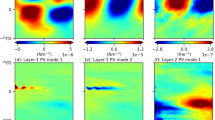Abstract
The variability present in a 1/6th degree Atlantic ocean simulation forced by analysed wind stress and heat flux over a 20-year period is investigated by means of heat transport diagnostics. A section is defined which follows the Gulf Stream and its seaward extension, and transport of heat across this section is analysed to reveal the physical mechanisms responsible for ‘intergyre’ heat exchanges on a variety of time scales. Heat transport across another section that crosses the Gulf Stream is also diagnosed to reveal the temporal behaviour of the ‘gyre’ circulation. The Ekman response to wind stress variations accounts for the annual cycle and much of the interannual variability in both measures. For the intergyre heat transports, cancellation by transient-mean flow terms leads to a very weak annual cycle. Transient eddies account for approximately half the total intergyre transport of 0.7 Petawatts. They also account for a significant fraction of the interannual variability, but separate experiments with repeated-annual-cycle forcing indicate that the transient eddy component of the heat transport variability is internally generated. Links between the intergyre transport, the wind-driven gyre circulation, the surface heat budget and the atmospheric ‘North Atlantic Oscillation’ are discussed.










Similar content being viewed by others
References
Barnier B (1998) Forcing the ocean. In: Chassignet E, Verron J (eds.) Ocean modelling and parametrization’, Kluwer, Dardrecht, NL, pp 45–80
Bjerknes J (1964) Atlantic air-sea interaction. Adv Geophys 10: 1–82
Crosnier L, B Barnier, Treguier A-M (2001) Aliasing of inertial oscillations in the 1/6°Atlantic circulation Clipper model: impact on the mean meridional heat transport. Ocean Modelling 3: 21–32
Czaja A, Marshall JC (2001) Observations of atmosphere-ocean coupling in the North Atlantic. QJR Meteorol Soc 127: 1893–1916
Eden C, Jung T (2001) North Atlantic interdecadal variability: oceanic response to the North Atlantic Oscillation (1865-1997). J Clim 14: 676–691
Frankignoul C, de Coetlogon G, Joyce TM, Dong S (2001) Gulf Stream variability and ocean-atmosphere interaction. J Phys Oceanogr 31: 3516–3529
Ganachaud A, Wunch C (2003) Large-scale ocean heat and freshwater transports during the world ocean circulation experiment. J Clim 16: 696–705
Garnier E, Barnier B, Siefridt L, Béranger K (2000) Investigating the 15 year air-sea flux climatology from the ECMWF reanalysis project as a surface boundary condition for ocean models. Int J Climatol 20: 1653–1673
Gulev S, Barnier B, Knochel H, Molines J.M, Cottet M(2003) Water mass transformation in the North Atlantic and its impact on the meridional circulation: insights from an ocean model forced by NCEP-NCAR reanalysis surface fluxes. J clim 16: 3085–3110
Hakkinen S (1999) Variability of the simulated meridional heat transport in the North Atlantic for periods 1951-1993. J Geophys Res 104: 10,991–11,007
Hansen DV, Bezdek HF (1996) On the nature of decadal anomalies in the North Atlantic sea surface termperature. J Geophys Res 101: 8749–8758
Hurrell JW (1996) Influence of variations in the extratropical wintertime teleconnections on Northern Hemisphere temperature. Geophys Res Lett 23: 665–668
Jayne SR, Marotzke J (2001) The dynamics of ocean heat transport variability. Rev Geophys 39: 386–411
Krahmann G, Visbeck M, Reverdin G (2001) Formation and propagation of temperature anomalies along the North Atlantic Current. J Phys Oceanogr 31: 1287–1303
Marshall JC, Johnson H, Goodman J (2001) A study of the interaction of the North Atlantic Oscillation with ocean circulation. J Clim 14: 1399–1421
Penduff T, Barnier B, Dewar WK, O’Brien JJ (2003) Dynamical response of the ocean eddy field to the North Atlantic Oscillation: a model-data comparison. J Phys Oceanogr (Accepted)
Pavia AM, Chassignet EP (2002) North Atlantic modelling of low frequency variability in mode water formation. J Phys Oceanogr 32: 2666–2680
Percival DB, Walden TA (1993) Spectral analysis for physical applications. Multitaper and conventional univariate techniques. Cambridge University Press, Cambridge, UK
Reynolds RW, Smith TM (1994) Improved global sea surface temperature analyses using optimum interpolation. J. Clim 7: 929-948
Saravanan R, McWilliams J (1997) Stochasticity and spatial response in interdecadal climate fluctuations. J Clim 10: 2299–2320
Sutton R, Allen M (1997) Decadal predictability of North Atlantic sea surface temperature and climate. Nature 388: 363–367
Taylor AH, Stephens JA (1998) The North Atlantic Oscillation and the latitude of the Gulf Stream. Tellus 50A: 134–142
Treguier A-M, Barnier B, de Miranda A, Molines J-M, Grima N, Imbard M, Madec G, C Messager Michel S (2001) An eddy permitting model of the Atlantic circulation: evaluating open boundary conditions. J Geophys Res 106: 22 ,115–22,129
Visbeck M, Cullen H, Krahmann G, Naik N (1998) An ocean model’s response to North Atlantic Oscillation like wind forcing. Geophys Res Lett 25: 4521–4524
Visbeck M, Chassignet EP, Curry RG, Delworth TL, Dickson RR, Krahmann G (2003) The ocean’s response to North Atlantic Oscillation variability. In: The North Atlantic Oscillation: climate significance and environmental impacts, Hurrel JW, Kushnir Y, Ottersen G, Visbeck M,eds. Geophysical Monograph Series 134: pp 279
Acknowledgements
We are very grateful to Arnaud Czaja for help with calculation of spectra and for useful comments. We thank the reviewer for comments that helped us to clarify some of the discussion. This work was funded by a fellowship from the European Union and the Centre National de la Recherche Scientifique. Support for computations was provided by the Institut du Développement et des Recources en Information Scientifique (IDRIS). The CLIPPER project was supported by the Institut Nationale des Sciences de l’Univers (INSU), the Institut Francais de Recherche pour l’Exploitation de la Mer (IFREMER), the Service Hydrographique et Océanographique de la Marine (SHOM) and the Centre Nationale d’Etudes Spatiales (CNES).
Author information
Authors and Affiliations
Corresponding author
Rights and permissions
About this article
Cite this article
Hall, N.M.J., Barnier, B., Penduff, T. et al. Interannual variation of Gulf Stream heat transport in a high-resolution model forced by reanalysis data . Climate Dynamics 23, 341–351 (2004). https://doi.org/10.1007/s00382-004-0449-2
Received:
Accepted:
Published:
Issue Date:
DOI: https://doi.org/10.1007/s00382-004-0449-2



